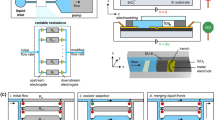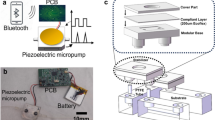Abstract
Microfluidic devices with integrated pneumatic logic enable automated fluid handling without requiring external control instruments. These chips offer the additional advantage that they may be powered by vacuum and do not require an electricity source. This work describes a microfluidic converging-diverging (CD) nozzle optimized to generate vacuum at low input pressures, making it suitable for microfluidic applications including powering integrated pneumatic logic. It was found that efficient vacuum pressure was generated for high aspect ratios of the CD nozzle constriction (or throat) width to height and diverging angle of 3.6o. In specific, for an inlet pressure of 42.2 psia (290.8 kPa) and a volumetric flow rate of approximately 1700 sccm, a vacuum pressure of 8.03 psia (55.3 kPa) was generated. To demonstrate the capabilities of our converging - diverging nozzle device, we connected it to a vacuum powered peristaltic pump driven by integrated pneumatic logic and obtained tunable flow rates from 0 to 130 μL/min. Finally, we demonstrate a proof of concept system for use where electricity and vacuum pressure are not readily available by powering a CD nozzle with a bicycle tire pump and pressure regulator. This system is able to produce a stable vacuum sufficient to drive pneumatic logic, and could be applied to power automated microfluidics in limited resource settings.






Similar content being viewed by others
References
R. B. Bird, Transport phenomena. Appl Mech Rev 55, R1–R4 (2002)
D. S. Chang, S. M. Langelier, M. A. Burns, An electronic Venturi-based pressure microregulator. Lab Chip 7, 1791–1799 (2007)
D. S. Chang, S. M. Langelier, R. I. Zeitoun, M. A. Burns, A Venturi microregulator array module for distributed pressure control. Microfluid Nanofluid 9, 671–680 (2010)
C Curtis B Eshaque, K Badali and V Karanassios (2012). Rapid prototyping of a microfluidics-based Venturi micropump imprinted on polymeric, postage-stamp-sized chips. p. 83660P–83660P–8.
P. N. Duncan, T. V. Nguyen, E. E. Hui, Pneumatic oscillator circuits for timing and control of integrated microfluidics. Proc Natl Acad Sci 110, 18104–18109 (2013)
P. N. Duncan, S. Ahrar, E. E. Hui, Scaling of pneumatic digital logic circuits. Lab Chip 15, 1360–1365 (2015)
T. Gervais, J. El-Ali, A. Günther, K. F. Jensen, Flow-induced deformation of shallow microfluidic channels. Lab Chip 6, 500–507 (2006)
W. H. Grover, A. M. Skelley, C. N. Liu, E. T. Lagally, R. A. Mathies, Monolithic membrane valves and diaphragm pumps for practical large-scale integration into glass microfluidic devices. Sensors Actuators B Chem 89, 315–323 (2003)
W. H. Grover, R. H. C. Ivester, E. C. Jensen, R. A. Mathies, Development and multiplexed control of latching pneumatic valves using microfluidic logical structures. Lab Chip 6, 623–631 (2006)
E. C. Jensen, W. H. Grover, R. A. Mathies, Micropneumatic Digital Logic Structures for Integrated Microdevice Computation and Control. J Microelectromech Syst 16, 1378–1385 (2007)
B. J. Kirby, Micro- and Nanoscale fluid mechanics: transport in (Microfluidic Devices Cambridge University Press, New York, 2010)
K. Koo, S. Lee, D. D. Cho, Fabrication of a micro-fluid gathering tool for the gastrointestinal juice sampling function of a versatile capsular endoscope. Sensors 11, 6978–6990 (2011)
D Li, Y Ji, W Liang, X Zhang H Yu, and K Xu (2013). A portable instrument for continuous glucose monitoring by the integration of microfluidic chip and micro-glucose sensor. pp. 861519–861519–11.
T. V. Nguyen, P. N. Duncan, S. Ahrar, E. E. Hui, Semi-autonomous liquid handling via on-chip pneumatic digital logic. Lab Chip 12, 3991–3994 (2012)
F. Perdigones, A. Luque, J. M. Quero, PDMS microdevice for precise liquid aspiration in the submicroliter range based on the Venturi effect. Microelectron Eng 87, 2103–2109 (2010)
M. Rhee, M. A. Burns, Microfluidic pneumatic logic circuits and digital pneumatic microprocessors for integrated microfluidic systems. Lab Chip 9(21), 3131–3143 (2009)
A.H. Shapiro, The dynamics and thermodynamics of compressible fluid flow (Ronald Press, New York, 1953), pp. 1953–54
H. Yu, D. Li, R. C. Roberts, K. Xu, N. C. Tien, Design, fabrication and testing of a micro-Venturi tube for fluid manipulation in a microfluidic system. J Micromech Microeng 22, 35010 (2012)
Acknowledgments
This work was supported by National Science Foundation 1253060, DTE.
Author information
Authors and Affiliations
Corresponding author
Electronic supplementary material
Fig. S1
Inlet pressure of the converging-diverging microfabricated nozzles of 3.6o angle of the diverging part and the acquired vacuum pressure for different heights and of different throat width of (a) 30 μm (b) 50 μm (c) 80 μm and (d) 100 μm. It is observed that the wider the throat width the less vacuum is obtained. This observation halts at heights smaller than 150 μm (GIF 121 kb)
Fig. S2
Volumetric flow rates for different inlet pressures of the converging-diverging microfabricated nozzles of 3.6o angle of the diverging part and the acquired vacuum pressure for different heights and different throat width of (a) 30 μm (b) 50 μm (c) 80 μm and (d) 100 μm. It is observed that the wider the throat width the less vacuum is obtained. This observation halts at heights smaller than 150 μm (GIF 130 kb)
Rights and permissions
About this article
Cite this article
Christoforidis, T., Werner, E.M., Hui, E.E. et al. Vacuum pressure generation via microfabricated converging-diverging nozzles for operation of automated pneumatic logic. Biomed Microdevices 18, 74 (2016). https://doi.org/10.1007/s10544-016-0096-5
Published:
DOI: https://doi.org/10.1007/s10544-016-0096-5




